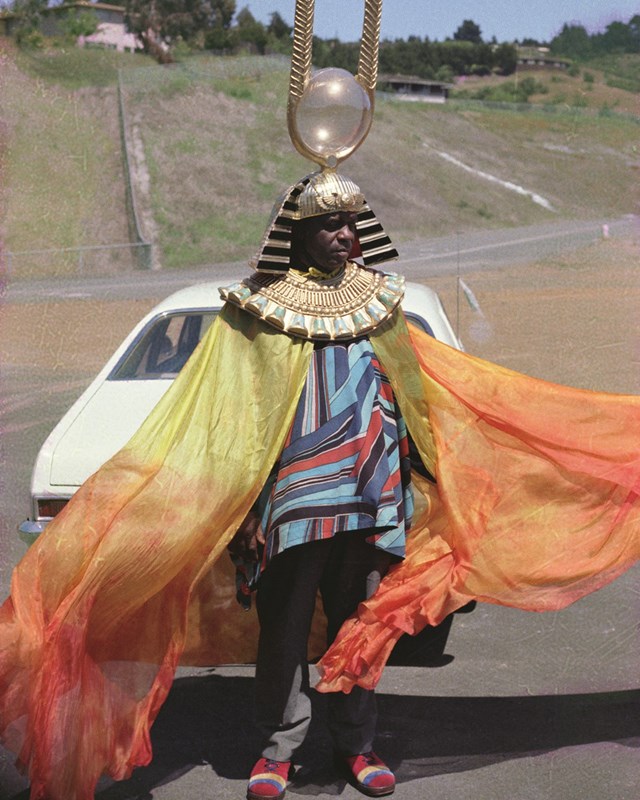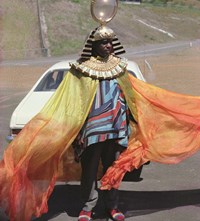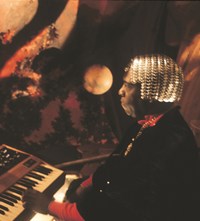The Radical Jazz Activist Who Worshipped Aliens
- TextPaul Moody
Sun Ra was a galactically-gifted sonic pioneer and, quite possibly, a brother from another planet – but who was the man behind the myth?
Taken from the A/W17 issue of Another Man:
New York, October 1979. Even in a city exploding with creative energy – punk, disco, hip hop – nothing can match the scenes onstage at the Squat Theatre on 23rd Street. In a tiny street-level club next door to the legendary Chelsea Hotel, fans including Nico – who lives upstairs – Debbie Harry, The B-52’s and Sonic Youth’s Thurston Moore have gathered to watch a stocky, middle-aged black man claiming to be from Saturn. Wearing a beatific smile and dressed in a rainbow-coloured cape, a tunic covered with astrological symbols and a chainmail skullcap, he leads his 15-piece band through three hours of free jazz, electro-funk, and volcanic blasts of atonal noise, culminating in a hypnotic mass chant of: “If you find earth boring / Just the same old same thing / Sign up for Outer Spaceways Incorporated…”
“I often felt I was experiencing a waking dream seeing Sun Ra,” says Michael Shore, a veteran of countless Squat Theatre shows as music critic for the Soho Weekly News. “I vividly recall him parading through the crowd very late one night, doing one of his sermons about how what we call life is a joke. He would exhort us, ‘Don’t give up your life for me, give up your death for me!’ That’s how heavy a Ra gig could be.”
“I often felt I was experiencing a waking dream seeing Sun Ra” – Michael Shore
Sun Ra was the ultimate riddle wrapped in a mystery, inside an enigma. A brilliant composer and arranger who pioneered the use of synthesisers and held a big band together for 40 years but was widely dismissed as a novelty act. A deep thinker who nursed deep grudges over inexplicable evils like slavery and racism, yet regularly ended shows with a rendition of Pink Elephants on Parade from Walt Disney’s Dumbo. The Godfather of Afrofuturism – and an inspiration to everyone from Afrika Bambaataa to Outkast to Janelle Monae – whose audience was predominantly white. No wonder Sun Ra despaired of humankind, and delighted in perpetuating his own myth. “That’s history,” he’d say in his chamomile-calm voice, when quizzed about his early life.
Sun Ra was always destined to cast spells. Named after an itinerant local magician called ‘Black Herman’, he was born Herman Poole Blount on 22nd May 1914, in Birmingham, Alabama, then one of the most segregated cities in the world (whites and blacks even had their own shopping days). From an early age his life seemed touched by otherworldly forces. Raised largely by his aunt Ida, a local spiritualist, he grew up opposite the train terminus where a huge sign pronounced ‘The Magic City’, a reference to Birmingham’s booming iron and steel industries.
Nicknamed ‘Sonny’ and taciturn by nature, as a child he spent most of his time at the piano – a seventh birthday present. Naturally gifted, he was playing in his teachers’ group at 13, and as a student at Alabama’s A&M University in Huntsville quickly took control of the school band, transcribing swing classics like Fletcher Henderson and Yeah Man for appreciative audiences.
Acutely aware that he felt ‘different’ from his contemporaries – accentuated by a chronic testicular hernia which put him off sex for life – an incident at college in 1936 propelled his sense of ‘otherness’ into a whole new dimension. Blount claimed that he had been abducted by aliens (admittedly he didn’t tell anyone about the experience until 1953), who took him to Saturn and informed him of his role as a spirit guide for a planet heading towards disaster.
“[He] claimed that he had been abducted by aliens (admittedly he didn’t tell anyone about the experience until 1953), who took him to Saturn and informed him of his role as a spirit guide for a planet heading towards disaster”
Denied a medical exemption on America’s entry into WWII despite a poignant letter to the draft board where he confessed, “I am a little afraid of normal people. Their greatest desire in life seems to be to maim and destroy either themselves or others,” he was eventually shipped to a CPS (Civilian Public Service) camp in Pennsylvania, before being discharged for his disability. Disillusioned by the experience and, by now, obsessively interested in esoteric subjects ranging from the Kabbalah, Egyptology, numerology and Flash Gordon, he moved to Chicago in 1946. In this hotbed of political activism he fell in with a group of young black radicals including future business partner Alton Abraham. Inspired into action, Blount changed his name legally in 1952 to Le Sony’r Ra (after the Egyptian sun god) and, together with Abraham, formed the El Saturn label, promoting ‘Sun Ra’ as a robed mystic from Saturn, the polar opposite of Italian suited jazz icons like Miles Davis.
So began a seemingly endless flood of album releases starting with 1956’s Super-Sonic Jazz, all in tiny quantities (75 or less) and packaged with handdrawn cover art. Impossible to fully catalogue, experts believe there to be at least 125 albums, making it one of the largest discographies in musical history. “Ra’s brain-twisting discography encompasses nearly a thousand titles with hundreds of musicians in countless configurations spanning six decades,” explains Kris Needs, a fan for almost 50 years and compiler of the 3-CD A Space Odyssey: From Birmingham to the Big Apple compilation. “To the beginner, it can look like an impossible mountain too high to even dare touch the foothills, but the rewards are immense for anyone who takes the time to explore it.”
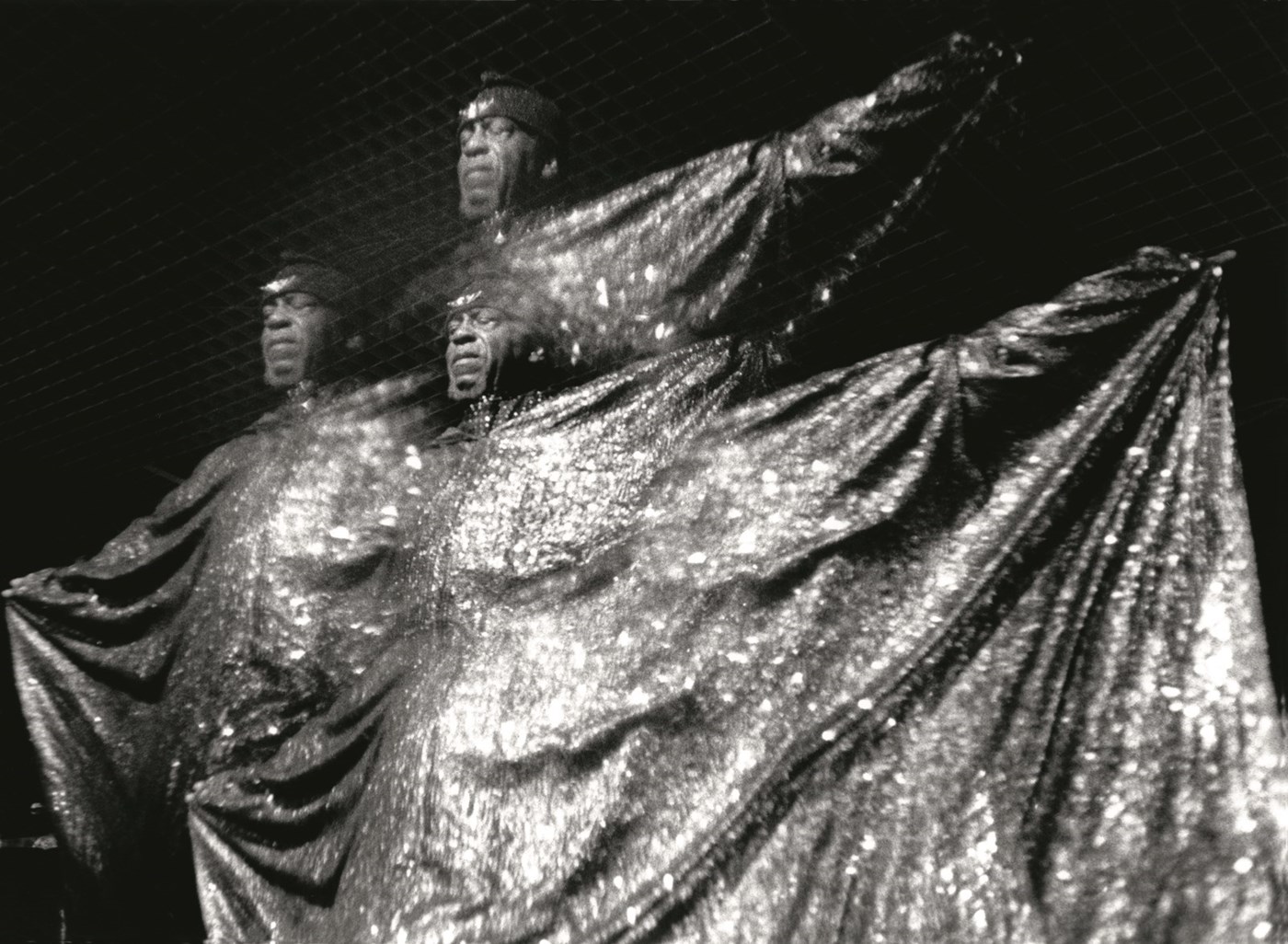
As the jazz era gave way to the pop age, Ra moved to New York in 1961, establishing the first ‘Ra House’ on East 3rd Street in the then disreputable East Village. With money tight, he recruited only those musicians prepared to live by his own puritanical code: no drugs, no women and barely any food other than Ra’s homemade ‘moon stew’ (a mix of green peppers, onion, garlic, potatoes, okra, tomatoes, and ears of corn). To keep the band on their toes, rehearsals could start at any minute, and often last for 12 hours.
By the end of 1964, word had reached the rock underground about this otherworldly figure claiming to be from outer space. “I first heard his music when (Arkestra drummer) Roger Blank stayed at our house in Detroit,” explains counterculture icon and former MC5 manager John Sinclair. “The music was terrific and the album packages were spectacular. We were on the same track in terms of creativity, outness, defiance, and a willingness to work outside the mainstream.” Excited at the possibilities of a creative alliance, Sinclair invited Sun Ra to play at Detroit’s Wayne State University. “It was artistically magnificent,” he says, recalling a show that saw both bands framed in a psychedelic light show by The Magic Veil, “but the attendance wasn’t at all commensurate with the occasion; less than 200 as I recall.”
“By the end of 1964, word had reached the rock underground about this otherworldly figure claiming to be from outer space”
Despite this growing word-of-mouth fanbase, it wasn’t until the start of the new decade that a compilation called The Heliocentric Worlds of Sun Ra was released in the UK. “It’s a crime that for so long we’ve been denied most of the music of Sun Ra and his Solar Arkestra,” ran the review in Melody Maker in January 1970. “A band which plays with complete freedom, and yet which is very evidently ordered by a musical intelligence of a high degree. On this evidence, Sun Ra had it together a long time ago.”
It was a move to another ‘Ra House’ in Philadelphia later the same year that saw Ra reach new creative heights. Featuring a 22-minute version of the title track, 1972’s Space is the Place was the perfect distillation of Ra’s sound, his lifelong obsessions with space travel and black emancipation suddenly in vogue in the wake of the moon landings and the growth of the civil rights movement.

Miraculously, a low-budget film of the same name – made in 1972 but released two years later – went one step further, capturing Ra’s out-there philosophy on celluloid.
In Space is the Place, Ra plays himself as an interplanetary time-traveller who uses music to encourage young African Americans to resettle on his own peace-loving planet. With nods to everything from 50s sci-fi classic The Day the Earth Stood Still to Ingmar Bergman’s The Seventh Seal, it inverts the masculine blaxploitation stereotypes popularised in Shaft and Superfly. Instead, the jive-talking hustler Jimmy Fey (played by Christopher Brooks) with his worldly fixation on money and status epitomises everything preventing black Americans from fulfilling their potential. Full of fabulous set-pieces, including one where Ra interviews potential evacuees from Earth at his own ‘Outer Space Employment Agency’, it nonetheless sunk without trace (the full 85-minute cut wasn’t released until 2003).
“The downtown art, post-punk and disco set had no problem accepting him as a prophet and visionary”
As a metaphor for a career spent refusing to compromise and suffering the consequences, it’s just about perfect. It’s little wonder that the nascent punk scene bubbling up in New York in the mid 70s, the ultimate outsider cult, took to Ra so readily.
“The downtown art, post-punk and disco set had no problem accepting him as a prophet and visionary,” explains Kris Needs, then resident in the city. “The Arkestra even recorded an album at Bob Blank’s studio, where The Contortions and other no-wavers made their noise. At a time when post-punk music could seem dull and dowdy, Sun Ra and his Arkestra were the opposite: exotic and full of life.”
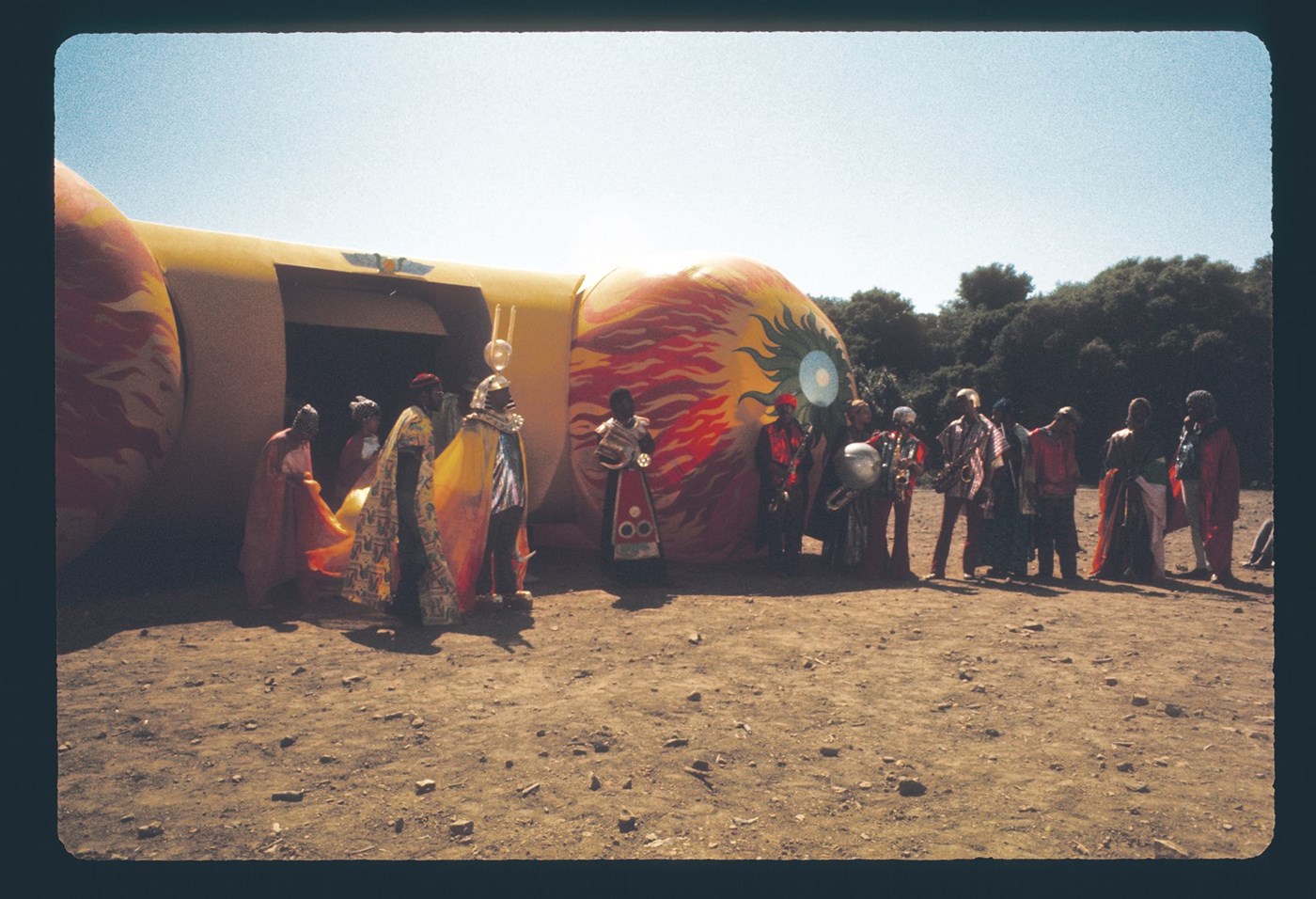
The patronage of the countless bands inspired by punk – including Sonic Youth, Primal Scream and Spiritualized – helped Ra achieve cult status throughout the 1980s and early 90s, playing 250 shows a year everywhere from country & western bars to student unions. However, while Ra was wholeheartedly accepted by the alternative rock scene, his lack of recognition within his own community, particularly in his adopted hometown of Philadelphia, made him bitter. “The city has insulted me,” he said in 1988. “I’ve been in this city long enough to be respected. There’s a conspiracy, not by the government, I don’t know who, to keep my music down.”
In retrospect, those legendary Squat Theatre shows seem like a microcosm of Ra’s entire career. For those in the know, he represented everything pure about music: a true visionary who stayed true to his mission to free the black race from bondage. “It always broke my heart that so few black folks seemed to care about what Sun Ra was doing,” says Michael Shore today. “Ra is now seen as the godfather of Afrofuturism, which is nice. But I personally think Ra created one of the most beautiful, powerful, and remarkable statements of African-American culture ever.”
“I personally think Ra created one of the most beautiful, powerful, and remarkable statements of African-American culture ever” – Michael Shore
Sun Ra suffered a stroke in October 1992 and returned to his native Birmingham for medical care before his death on 30th May 1993, at the age of 80. Tellingly, he signed his address in the hospital admissions book as ‘Saturn’. The self-styled “ambassador from the intergalactic regions of outer space” was going home.
24 years on, the cult of Sun Ra continues to grow. The Arkestra, now led by 93-year-old saxophonist Marshall Allen, continue to tour (they play three nights in London this October) while countless tribute bands, including former Specials keyboardist Jerry Dammers’ Spatial AKA Orchestra, keep his music alive. “Sun Ra’s music doesn’t get the recognition it should because it was so creative and far-reaching,” says John Sinclair in conclusion. “He was too heavy for our one-dimensional commercial music world.”
